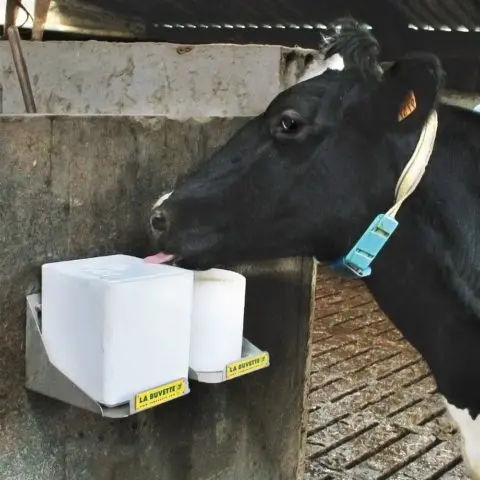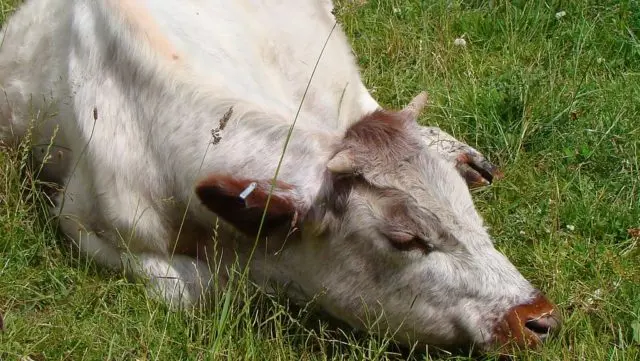Contents
Salt poisoning of cattle is a serious violation that can lead to the death of an animal in a matter of hours. Inexperienced farmers and homeowners often recognize the symptoms of this dangerous condition at an advanced stage. To prevent poisoning and avoid the death of the livestock of cattle, each owner must be able to recognize the first signs of an overdose and familiarize himself with the rules for helping an animal with salt intoxication.
Causes of salt poisoning
Table salt (sodium chloride) is an important component of the cattle diet. Most feeds and feed mixtures do not satisfy the animal’s need for vital macronutrients – sodium and chlorine. These important macronutrients, concentrated mainly in soft tissues and body fluids, perform the following functions:
- regulation of water exchange in the body;
- maintenance of acid-base balance, osmotic pressure and volume of fluids in the body;
- chlorine is part of the gastric secretion (hydrochloric acid), which is necessary to create an acidic environment in the stomach and activate digestive enzymes;
- sodium promotes the absorption of glucose in the intestine, activates the action of the enzyme amylase.

In the diet of cattle, the content of these macronutrients is normalized by introducing table salt. With the correct organization of feeding cows, the required amount of table salt is calculated based on the weight of the animal. For cattle, the rate of consumption of table salt per day is 5 g per 100 kg of body weight. For high-yielding cows, the salt rate is increased by another 4 g per 1 liter of milk yield.
The need for mineral supplements in cattle increases when eating silage. Ensiled feeds have a more acidic pH, so the salivary glands of the animal produce a secretion with a higher content of sodium bicarbonate to neutralize acids than, for example, when feeding roughage or fresh grass.
An excess of salt in the diet of cattle can lead to intoxication. Most often, salt poisoning in cows occurs:
- with excessive intake of sodium chloride with feed;
- after a long salt starvation;
- with insufficient drinking.
Salt poisoning symptoms in cows
Signs of salt intoxication appear approximately 1-2 hours after consuming an excess amount of sodium chloride. Salt poisoning in cattle can be identified by the following symptoms:
- lack of chewing gum and appetite;
- gnashing of teeth;
- vomiting, shortness of breath;
- profuse salivation;
- strong thirst;
- hypotension of the stomach;
- frequent urination;
- diarrhea;
- depression, weakness.
When using a large dose of salt, the content of sodium ions in the blood plasma exceeds the norm by 1,5-2 times. The components of table salt are deposited in the soft tissues of the body, the permeability of cell membranes, osmotic pressure in tissues and their dehydration are disturbed. Due to electrolyte imbalance (Na / K and Mg / Ca), the protein-lipid membrane of the cells of the nervous system is depolarized and, as a result, reflex activity is disturbed, the nervous system is overexcited. With salt poisoning in cattle, muscle tremors, convulsions and paralysis of the limbs can also be observed. In calves with salt poisoning, as in adult animals, the following are noted:
- violation of coordination of movements;
- rapid breathing;
- decrease in body temperature;
- opisthotonus.
With regular feeding of feed and feed with a high content of sodium chloride (subtoxic doses) to cows, chronic intoxication occurs, which is characterized by diarrhea, frequent urination and general depression.

Treatment of salt poisoning in cattle
Excess sodium in the body leads to metabolic disorders, oxygen starvation (hypoxia) and death of the animal. Signs of acute poisoning appear soon after ingestion of excess sodium chloride.
When the first symptoms of salt poisoning appear in cattle, treatment should be started immediately. First of all, you need to seek help from a veterinarian. Only a specialist will be able to differentiate table salt intoxication from other types of poisoning.
In order to prevent dehydration of the body, a sick animal must be provided with abundant water. If the animal is not able to drink on its own, water is administered through a food tube or rectally. An antidote is administered intravenously – 10% calcium chloride solution according to the dosage and depending on the weight of the animal (1 ml per 1 kg), glucose solution (40%) intravenously at 0,5-1 ml per 1 kg of animal weight.
Orally prescribed:
- milk;
- vegetable oil;
- starch solution;
- decoction of flaxseed;
- adsorbents.
Prognosis and prevention
In acute poisoning and the rapid development of clinical signs, the prognosis is unfavorable. The sooner the symptoms of intoxication are detected and appropriate measures are taken, the greater the chances of the animal recovering.
To prevent salt intoxication of cattle, it is necessary:
- comply with the norms of giving salt, taking into account the age, physiological state and productivity of the animal;
- after a long salt starvation, mineral supplements must be introduced gradually;
- provide free access to clean fresh water.
When purchasing compound feed, it is necessary to carefully study their composition. In feed for cattle, the content of sodium chloride should not exceed 1-1,2%. Unscrupulous manufacturers often exceed this rate, since table salt is a fairly cheap raw material.
Conclusion
Poisoning of cattle with table salt is quite common. Intoxication occurs after salt starvation or consumption of feed (mixed feed) with a high content of sodium chloride. When the first signs of illness are detected, the owner of the animal should provide first aid and call a veterinarian as soon as possible. Severe poisoning with sodium chloride is practically not treated. The sooner treatment is started, the more favorable the further prognosis.









